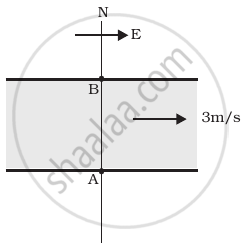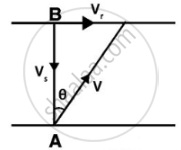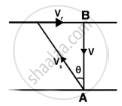Advertisements
Advertisements
Question
A river is flowing due east with a speed 3 m/s. A swimmer can swim in still water at a speed of 4 m/s (Figure).

- If swimmer starts swimming due north, what will be his resultant velocity (magnitude and direction)?
- If he wants to start from point A on south bank and reach opposite point B on north bank, (a) which direction should he swim? (b) what will be his resultant speed?
- From two different cases as mentioned in (a) and (b) above, in which case will he reach opposite bank in shorter time?
Solution
Analysis of Relative Velocity in Different Situations: The motion of a boat (or a swimmer) in running water, say, a river.
a. If the swimmer starts swimming due north, what will be his resultant velocity

Vs = 4 m/s due north
Vr = 4 m/s due east
Now since both directions are perpendicular,
|Vr|2 = 42 + 32 = 5 m/s
`tan θ = V_r/V_s` = 0.75 = 36°54' in the north direction
b. The swimmer wants to start from point A on the south bank and reaches the opposite point B on the north bank

The swimmer makes an angle θ with the north.
From the figure, we have the relation,
`V^2 = v_s^2 = 16 - 9 = 7`
Hence `v = sqrt(7)` m/s
Now we calculate the value of θ through the below formula,
`tan θ = v_r/v = (3sqrt(7))/7` = 1.13
So, θ = 48°29'30'' in the direction from north to west
c. We need to find from the above two scenarios that for the swimmer to reach the opposite bank in the shorter time
We know that the velocity component perpendicular to the river is 4 m/s
Let us assume the width of the river to be 'w'
Time taken – North
`w/4 = t_1`
Time is taken in part b. when `v = sqrt(7)` m/s
`w/sqrt(7) = t2`
Raking ratio,
`(t_1)/(t_2) = ((w/4))/((w/sqrt(7)))`
`4 t_1 = sqrt(7) t_2`
Now as , `4 > sqrt(7)`
`t_1 < t_2`
So, the summer will take a shorter time in case a.
APPEARS IN
RELATED QUESTIONS
A passenger arriving in a new town wishes to go from the station to a hotel located 10 km away on a straight road from the station. A dishonest cabman takes him along a circuitous path 23 km long and reaches the hotel in 28 min.
- What is the average speed of the taxi,
- the magnitude of average velocity? Are the two equal?
A vector has both magnitude and direction. Does it mean that anything that has magnitude and direction is necessarily a vector? The rotation of a body can be specified by the direction of the axis of rotation, and the angle of rotation about the axis. Does that make any rotation a vector?
Given a + b + c + d = 0, state whether the following statement is correct or incorrect:
a, b, c, and d must each be a null vector.
A, B and C are three non-collinear, non co-planar vectors. What can you say about direction of A × (B × C)?
